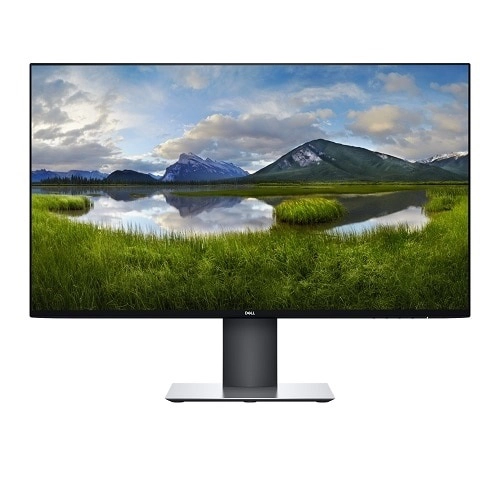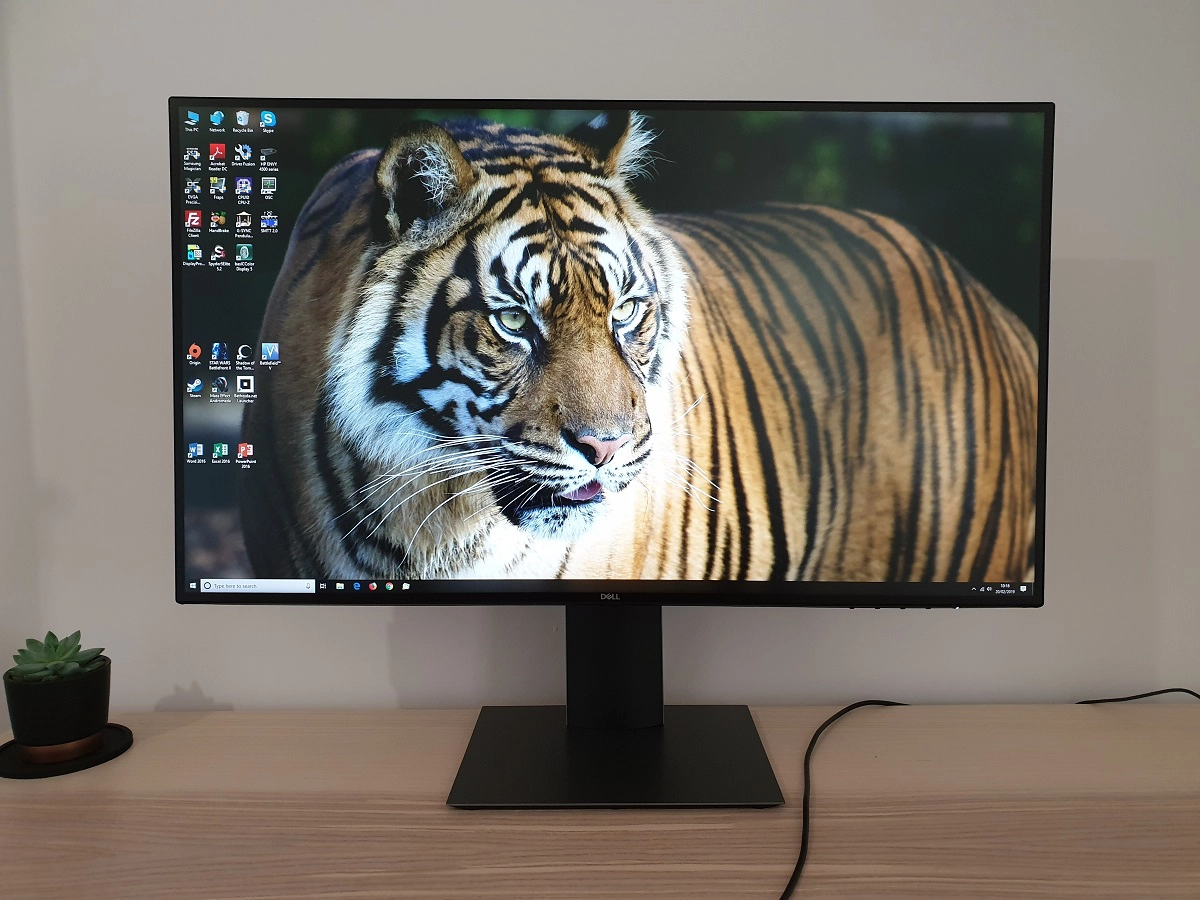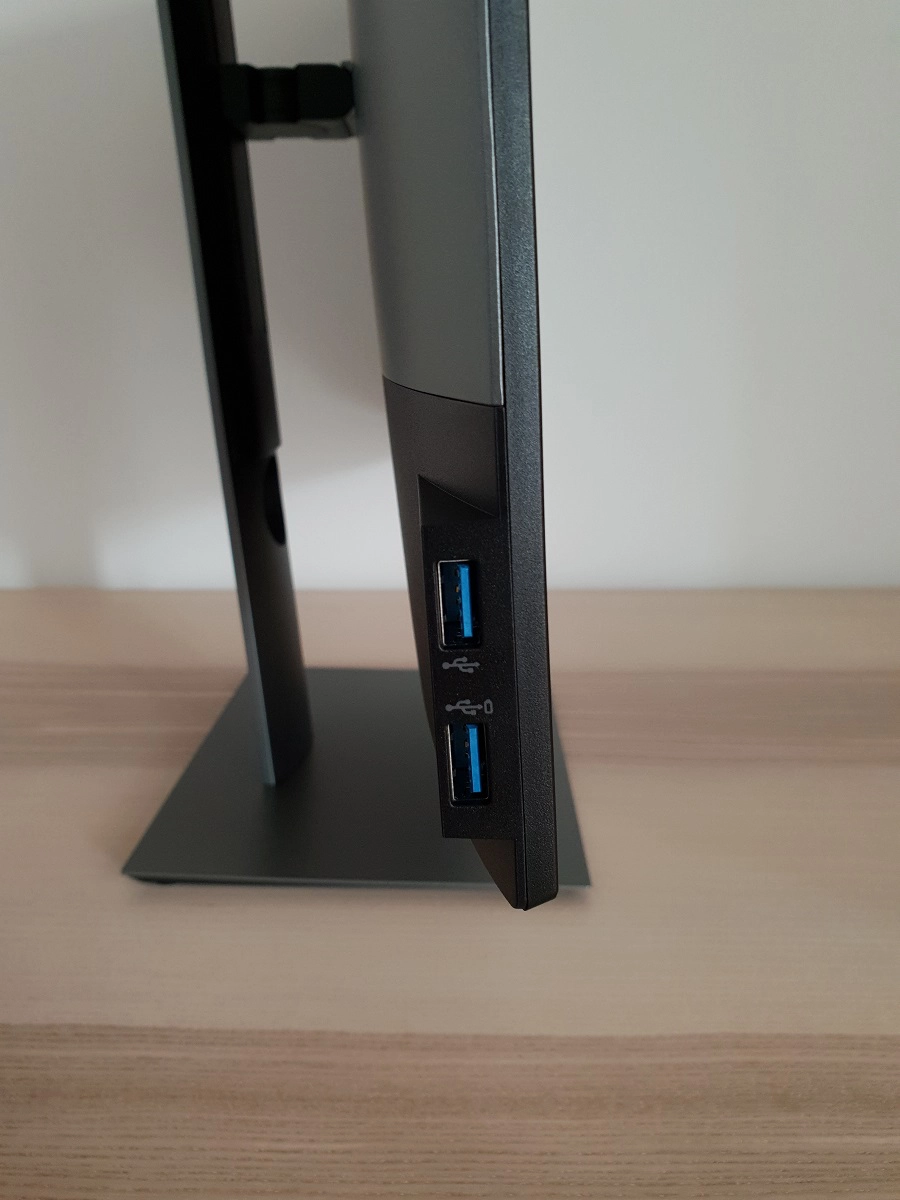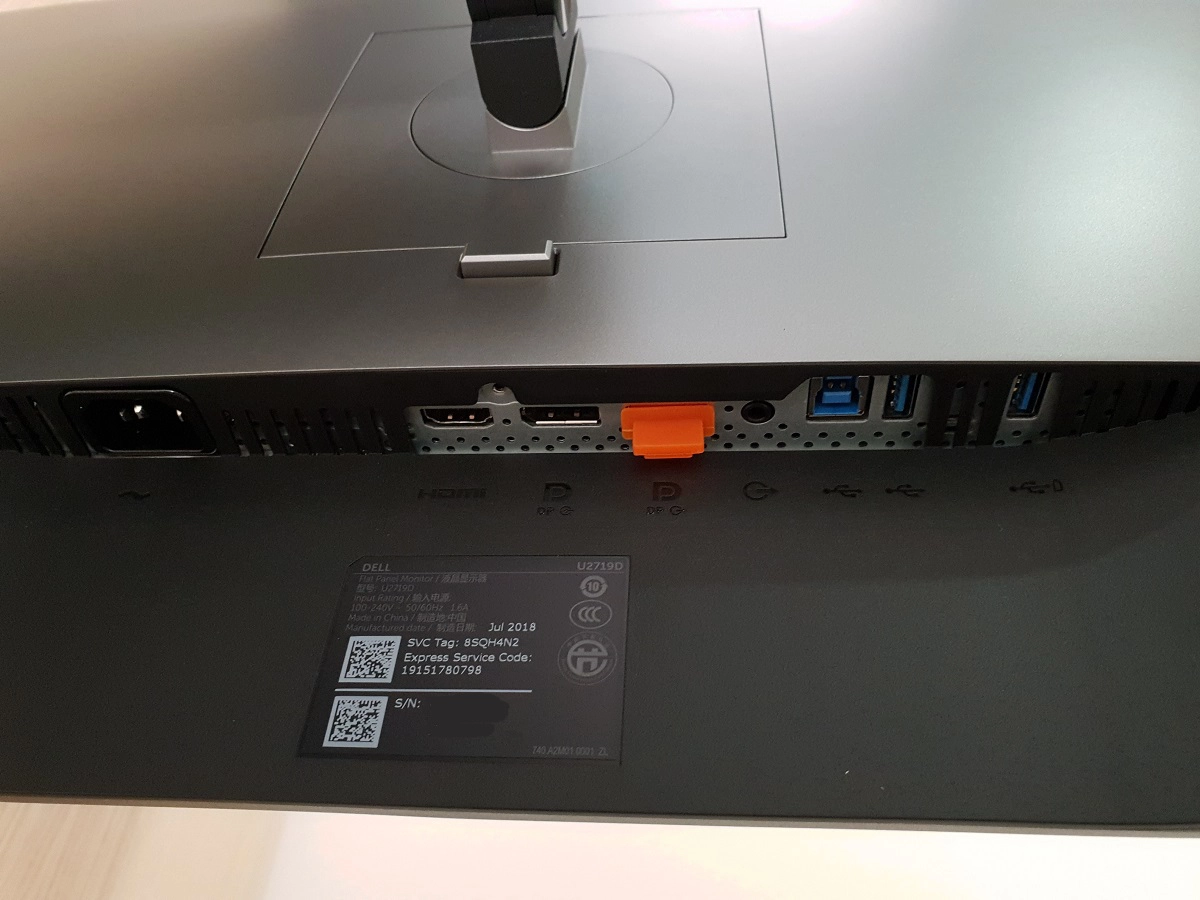Author: Adam Simmons
Date published: February 21st 2019
Table of Contents
Introduction
27” screens with a 2560 x 1440 (WQHD) resolution are a popular choice for many users, bringing a comfortable pixel density for both work and play. Dell’s UltraSharp series has long been a go-to choice for users looking for a 60Hz solution of this size and refresh rate. The Dell U2719D, of the UltraSharp series, continues the trend of ever-decreasing bezel size and minimalistic overall design. We put this model through its paces in our usual suite of tests to see how it performs and whether it lives up to the reputation that the series and brand has built up.
Specifications
The monitor uses a 27” Samsung PLS (Plane to Line Switching) IPS-type panel with a 60Hz refresh rate and support for true 8-bit colour. A 5ms grey to grey response time is specified, but as usual you shouldn’t put too much weight on this figure. Some of the key ‘talking points’ of the monitor have been highlighted in blue below.
As an Amazon Associate I earn from qualifying purchases made using the below link. Where possible, you’ll be redirected to your nearest store. Further information on supporting our work.
|
Features and aesthetics
The monitor features a sleek and minimalistic design, with slim bezels on all sides. A dual-stage design (‘4-side borderless’) is used, with a slim black panel border around the image and a very slender hard plastic outer component. Including both components, the bezels are ~7mm (0.28 inches) at the top and sides and ~8mm (0.31 inches) at the bottom. The bottom bezel slopes downwards towards the rear, the total width accounting for that is ~13mm (0.51 inches). The stand neck is matte black plastic, whilst the base is a fairly compact rectangular design with a matte silver plastic finish. The screen itself is the dominant feature from the front, with a medium (‘relatively light’) matte anti-glare finish used as explored shortly.
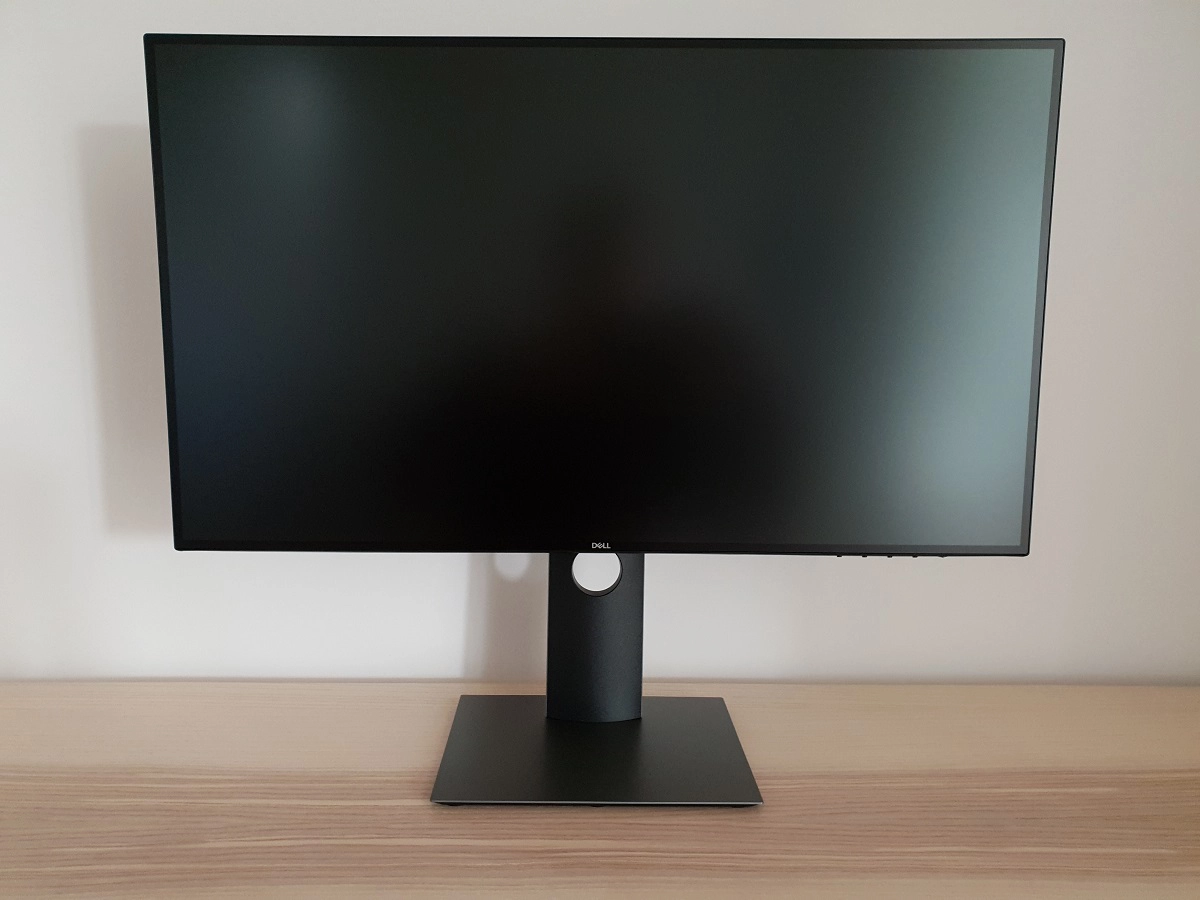
The OSD (On Screen Display) is controlled by pressable buttons on the underside of the bottom bezel, towards the right side. There is also a power button, with Dell’s preferred ‘vertical slit’ power indicator. This glows static white when the monitor is on and flashes when it enters a low power state (signal to the system is lost). The video below runs through the OSD menu system.
From the side the screen is very slender, about as slender as a model with internal power converter can be. It’s ~7mm (0.28 inches) at thinnest point and lumps out further towards the middle. The included stand offers full ergonomic flexibility; tilt (5° backwards, 21° forwards), height adjustment (130mm or 5.12 inches), swivel (40° left, 40° right) and pivot (90° clockwise or anti-clockwise rotation into portrait). At lowest height the screen clears the desk by ~36mm (1.42 inches) with the top of the screen ~398mm (15.67 inches) above the desk. The stand is much less of a space hog on the desk than some designs, with a total depth for the monitor and stand of ~179mm (7.05 inches). At the left side of the monitor there are 2 USB 3.0 ports (the bottom one supports BC 1.2 fast-charging).
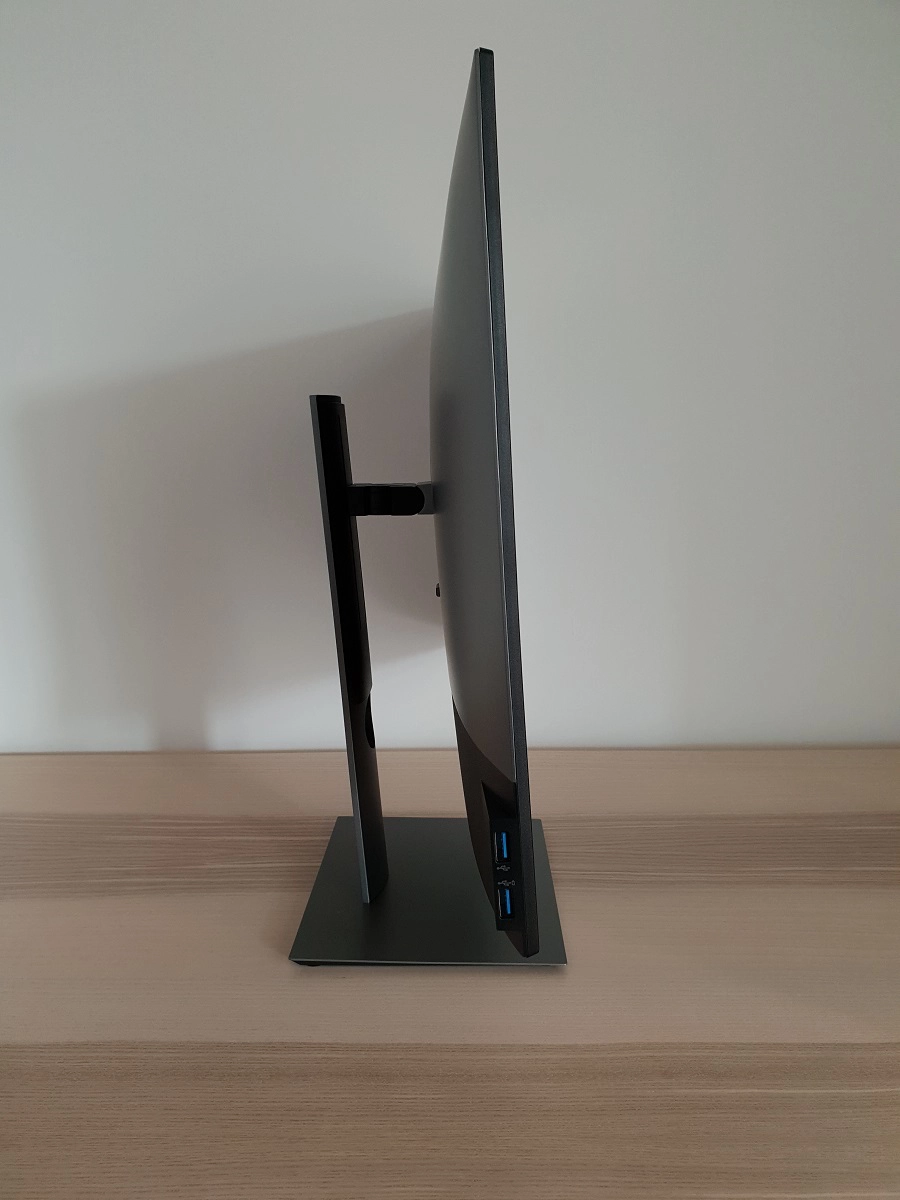
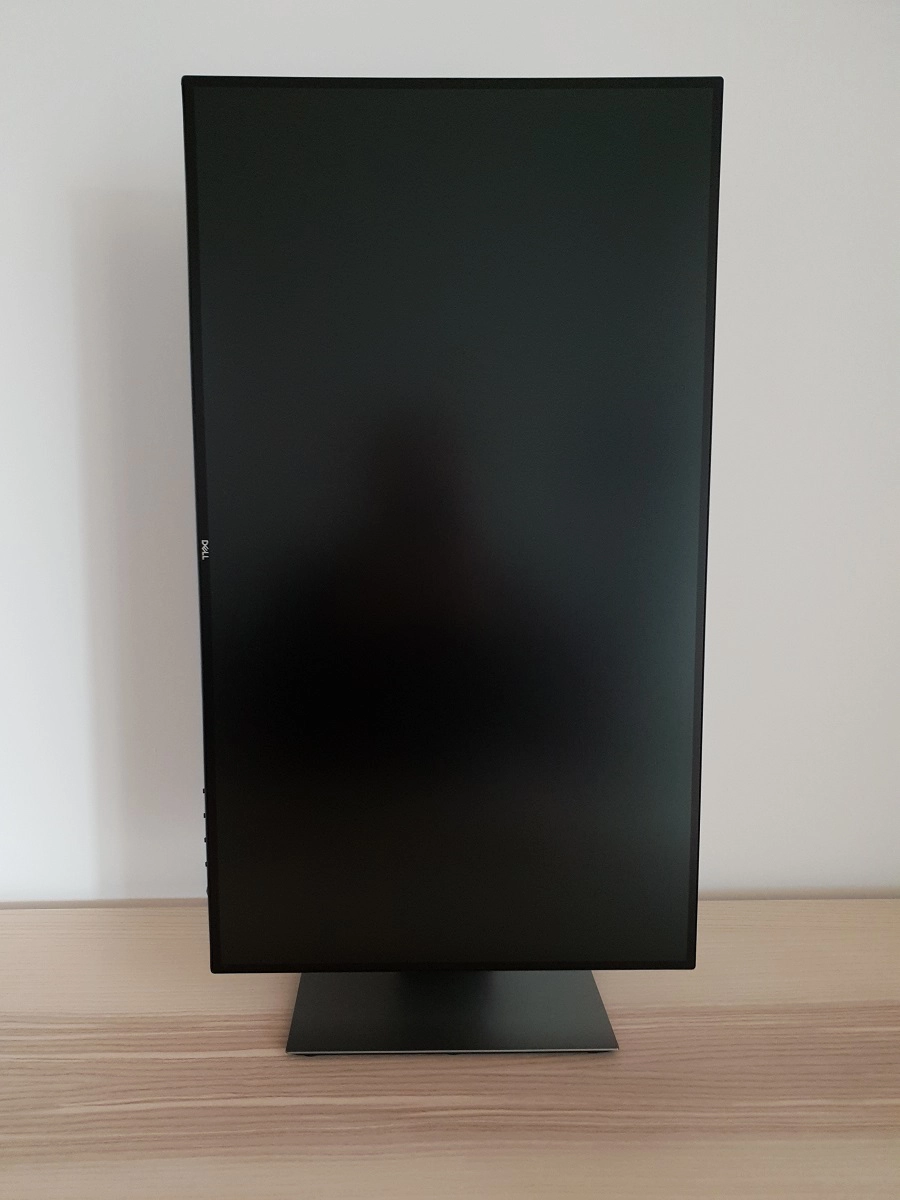
The rear of the monitor uses silver matte plastic predominantly with a bit of matte black plastic lower down. The stand attaches using a quick-release mechanism and can be released by pressing a button beneath the attachment point. This allows attachment of the screen to an alternative 100 x 100mm VESA compatible solution. Facing downwards beneath this region is a lock feature for the quick-release mechanism. The ports of the monitor face downwards and include; AC power input (internal power converter), HDMI 1.4, DP 1.4, DP 1.4 out (for MST daisy-chaining), 3.5mm audio output, USB 3.0 upstream and 2 further USB 3.0 ports (rightmost port supports BC 1.2 fast-charging). Towards the right of the port area there is a Kensington lock slot. Note that the DisplayPort output has an orange rubber plug over it in the box so that users don’t mistake it for the input and wonder why the monitor isn’t displaying an image.
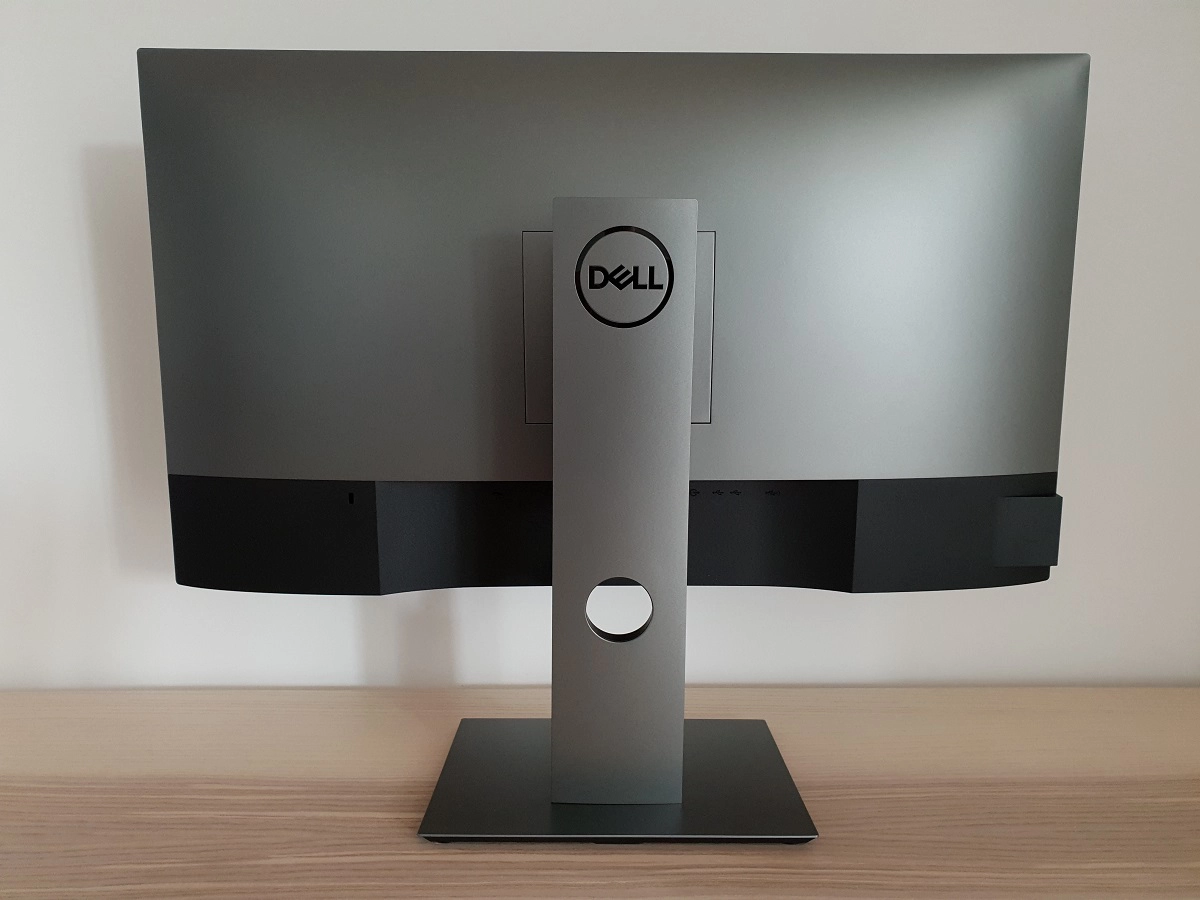
The full resolution and refresh rate are supported via either DP 1.2+ or HDMI 1.4 on this monitor. Note that both the DP 1.4 and HDMI 1.4 ports are HDCP 1.4 compliant as specified by Dell. A power cable, DP cable and USB 3.0 cable is included as standard. Note that some retailers stock the U2719DX which is exactly the same product except that it includes an HDMI cable rather than DP cable.
Calibration
Subpixel layout and screen surface
The images below are macro photographs taken on Notepad with ClearType disabled. The letters ‘PCM’ are typed out to help highlight any potential text rendering issues related to unusual subpixel structure, whilst the white space more clearly shows the actual subpixel layout alongside a rough indication of screen surface. This model uses a medium (or ‘relatively light’, depending on how you choose to classify it) matte anti-glare screen surface. This provides strong glare handling characteristics and imparts a light ‘misty’ graininess when observing lighter shades. It doesn’t give an obvious ‘smeary’ or layered graininess as some matte screen surface do, thankfully. The image clarity and vibrancy is therefore better preserved.
![]()
As shown above, the monitor uses the usual RGB (Red, Green and Blue) stripe subpixel layout. This is the typical layout expected by modern operating systems such as Microsoft Windows and Apple MacOS. You needn’t worry about text fringing from non-standard subpixel layouts as a Mac user and don’t need to run ClearType as a Windows user. Users may wish to run through the ClearType wizard and adjust according to preferences, however. The subpixel layout and arrangement is normal for the panel type and we had no subpixel-related concerns related to sharpness or text clarity on this model. You may notice that the subpixels are slightly squat with relatively thick black spaces between them vertically. On some models this can contribute towards thin horizontal or vertical bands (static ‘interlace patterns’). As we explore later, we didn’t observe any particular issues with this when running the monitor at its standard 60Hz refresh rate. These became noticeable (although still relatively faint) if the monitor was overclocked, however.
Testing the presets
The monitor includes various ‘Preset Modes’; ‘Standard’, ‘ComfortView’, ‘Multiscreen Match’, ‘Movie’, ‘Game’, ‘Color Temp.’ and ‘Custom Color’. We take a look at some of these presets (and some associated sub-settings) in the following table. We won’t be exploring all of them as we see little utility in some of them, but we do cover them all at least briefly in the OSD video from the previous section. The table below gives gamma readings taken using a DataColor Spyder5ELITE and white point measurements taken using a BasICColor SQUID 3 (X-Rite i1Display Pro), alongside general observations. Our test system uses Windows 10 with an Nvidia GTX 1080 Ti connected via DisplayPort. Similar observations were made using HDMI 1.4. No additional drivers or ICC profiles were specifically loaded and the monitor was left to run for over 2 hours before readings were taken. Aside from our ‘Test Settings’, where various adjustments were made, assume anything not mentioned was left at default. When viewing the figures in this table, note that for most PC users ‘6500K’ for white point and ‘2.2’ for gamma are good targets to aim for. Individual targets depend on individual uses, tastes and the lighting environment, however.
| Preset Mode | Gamma (central average) | White point (kelvins) | Notes |
| Standard (Factory Defaults) | 2.2 | 6483K | This uses the full factory calibration and gave a very well-balanced image. Things were consistently rich and natural-looking without unwanted tints or inappropriate sRGB saturation levels. |
| ComfortView | 2.2 | 5272K | This is an effective Low Blue Light (LBL) setting. It significantly reduces the strength of the blue channel, although maintains a strong green channel. The result is a significant reduction in blue light output (particularly if brightness is reduced) and a warm but noticeably green-tinted image. |
| Game | 2.2 | 6917K | As ‘Factory Defaults’ but a cooler and slightly more vibrant look to the image. Gamma tracking is slightly different (though averages ‘2.2’ still) and colour gamut is expanded somewhat, as explored later. This preset also unlocks the ‘Hue’ and ‘Saturation’ sliders. |
| Color Temp. 5000K | 2.2 | 5137K | An alternative but still very effective LBL setting. Although the colour temperature is marginally lower, the blue channel is slightly stronger than under ‘ComfortView’ (the red channel is also stronger – hence the lower colour temperature). Importantly, the green channel has been appropriately reduced. The image appears warm but better balanced, without a green tint. The blue light reduction is still significant (especially at reduced brightness), massively reduced from factory defaults. |
| Custom Color | 2.2 | 6918K | As ‘Game’ but colour channels are available instead of ‘Hue’ and ‘Saturation’. |
| Test Settings (see below) | 2.2 | 6496K | As ‘Custom Color’ with some tweaks to colour channels and reduced brightness. The image appears consistently rich and natural, with just a touch of extra vibrancy in places compared to the factory calibration. |
The monitor comes with a factory calibrated ‘Standard’ setting, complete with a calibration report (below) showing how various criteria are met. Our unit certainly offered strong ‘out of the box’ performance for this reason, with a well-balanced image and accurate shade output that satisfied both the eye and colorimeter. As we explore later, the ‘Standard’ preset slightly cuts down the colour gamut so it tracks as close to the sRGB reference space as possible. The remaining presets, including ‘Custom Color’ use the native gamut of the monitor which extends a little (but not extreme amount) beyond sRGB in some regions.
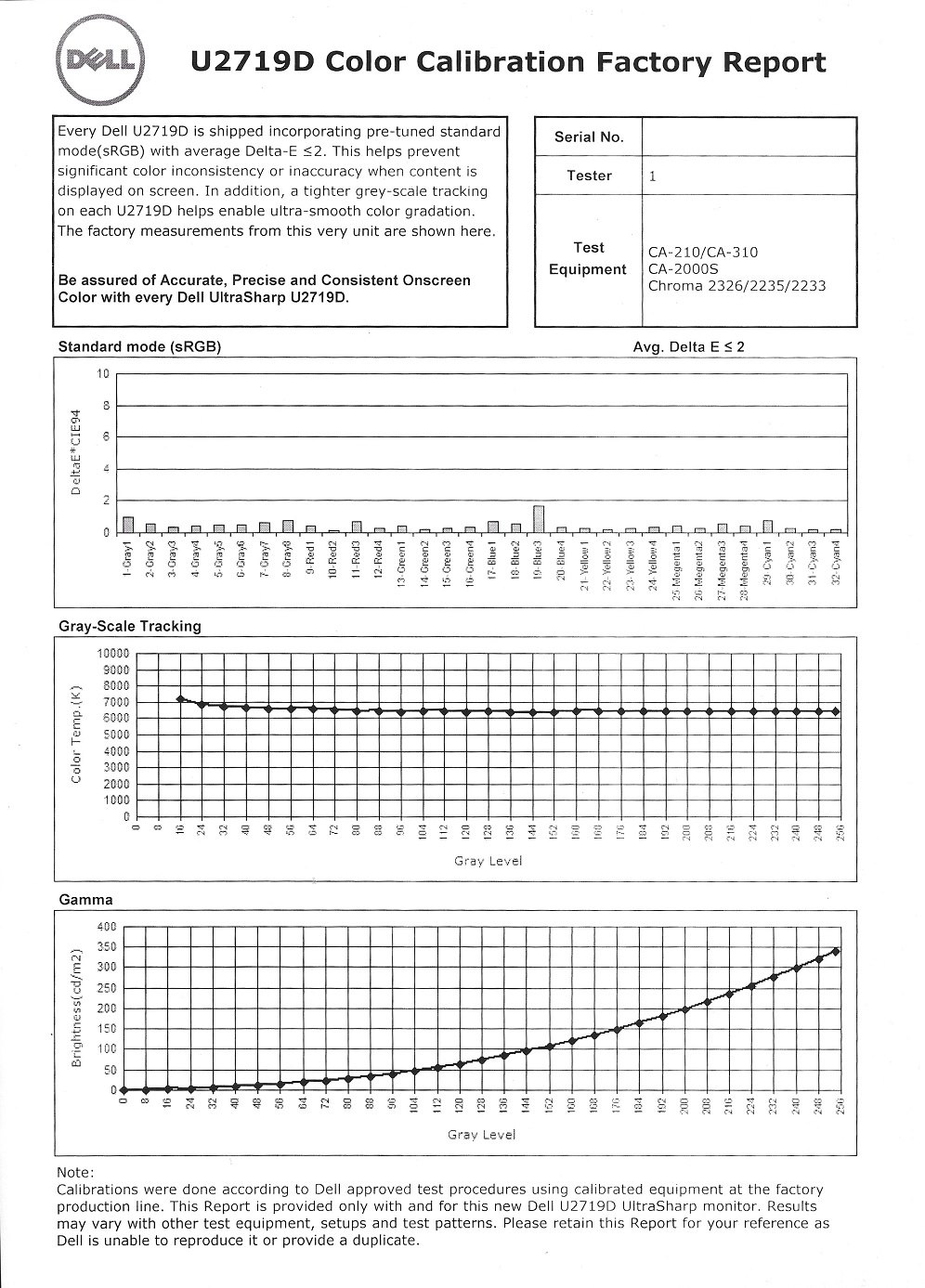
The gamma averaged ‘2.2’ across all settings we tested. There was some minor deviation from the curve in places, but nothing of particular concern. Dell calibrates gamma slightly differently to the ‘2.2’ standard under their ‘Standard’ preset. In a way that maintains the same image richness but improves low-end shade distinctions. You can see (first graph below) that gamma is slightly higher for some mid-tones, but only slightly. What isn’t clear from the (first) graph, due to the relatively low resolution of the graphic, is that the low-end has some intentional deviation from the ‘2.2’ curve (reduced gamma). This emphasises improved low-end distinctions compared to the standard ‘2.2’ curve, without taking things to extremes. Some users will prefer this as it helps offset some of the detail loss from ‘IPS glow’ and ~1000:1 static contrast and can be particularly useful for design and colour-critical work where low-end shade distinction is important. The second graph shows the results under our ‘Test Settings’. There are again minor deviations here, with the low-end showing gamma that’s a bit above rather than below ‘2.2’. Given the relatively strong performance with OSD tweaks alone and inter-unit variation we won’t be providing any ICC profiles. They would just prove counter-productive unless created by a user for their own individual unit.
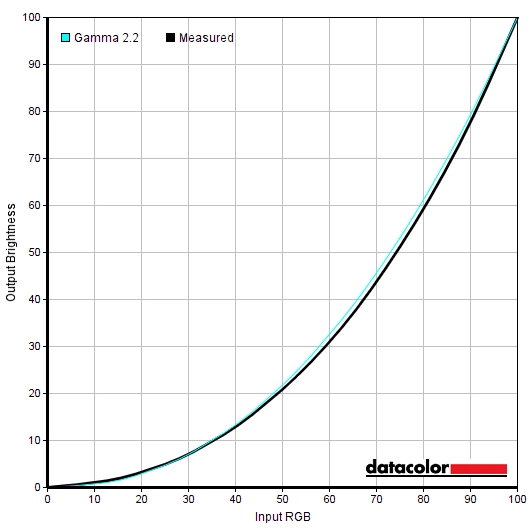
Gamma 'Standard'
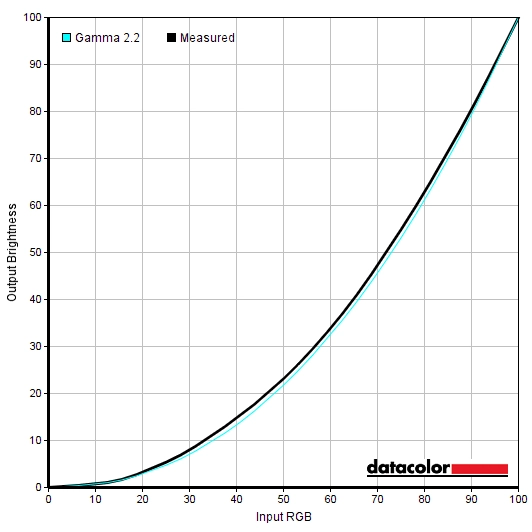
Gamma 'Test Settings'
The monitor also offers two LBL settings; ‘ComfortView’ and ‘Color Temp.’ set to ‘5000K’. Both were effective, but we preferred the latter as it offered a better balance to the image without the obvious green tint of the former. We used this ‘5000K’ setting for our own viewing comfort in the evenings, although not for specific testing beyond this particular setting. Because blue light is disruptive to sleep hormones, it’s important to cut it out as much as possible in the hours leading up to sleep. These settings offer the user an easy way to achieve that. As covered in the OSD video, you can assign one of these settings to a ‘Shortcut Key’ and your regular settings to another ‘Shortcut Key’ so can quickly activate or deactivate the setting.
Test Settings
Although the ‘Standard’ preset and full factory calibration was undeniably strong on our unit, we preferred using the ‘Custom Color’ setting with a few tweaks. The colour gamut is expanded slightly and things look a touch more vibrant. This fits in with our own preferences better, but users should certainly feel free to use the ‘Standard’ preset instead. Particularly if they’re interested in the strongest ‘out of the box’ colour accuracy and low-end shade distinction. Or if they just want to concern themselves with adjusting brightness, assuming their factory calibration is as strong as on our unit. Note that individual units and preferences vary, so consider this a suggestion that won’t necessarily be optimal for all users. We’ve included our response ‘Response Time’ setting used as well, just for reference. Assume any setting not mentioned, including ‘Contrast’, was left at default.
Preset Mode= Custom Color
R= 100%
G= 98%
B= 96%
Brightness= 45% (according to preferences and lighting)
Response Time= Normal
Contrast and brightness
Contrast ratios
A BasICColor SQUID 3 (X-Rite i1Display Pro) was used to measure the luminance of white and black using a range of monitor settings, including those analysed in the calibration section. From these values, static contrast ratios were calculated. Results are show in the table below. Blue highlights indicate the results using our ‘Test Settings’, whilst black highlights indicate the highest white luminance, lowest black luminance and maximum contrast ratio recorded. Assume any setting not mentioned was left at default, with the exceptions already noted in the table or in the calibration section.
| Monitor Profile | White luminance (cd/m²) | Black luminance (cd/m²) | Contrast ratio (x:1) |
| 100% brightness | 334 | 0.34 | 982 |
| 80% brightness | 257 | 0.26 | 988 |
| 60% brightness | 198 | 0.20 | 990 |
| 40% brightness | 144 | 0.15 | 960 |
| 20% brightness | 105 | 0.11 | 955 |
| 0% brightness | 40 | 0.04 | 1000 |
| 75% brightness (Factory Defaults) | 238 | 0.24 | 992 |
| ComfortView | 256 | 0.25 | 1024 |
| Game | 257 | 0.24 | 1071 |
| Color Temp. 5000K | 212 | 0.24 | 883 |
| Custom Color | 257 | 0.24 | 1071 |
| Custom Color (100% brightness) | 362 | 0.34 | 1065 |
| Test Settings | 164 | 0.16 | 1025 |
The average static contrast with only brightness adjusted was 975:1, which is as expected given the panel specifications. The maximum static contrast was recorded under the looser calibration of the ‘Custom Color’ and ‘Game’ presets; 1071:1. Following adjustments made to our ‘Test Settings’, we recorded 1025:1 which is quite good. The contrast remained strong using the ‘ComfortView’ LBL setting (1024:1) and dropped slightly under the better balanced ‘Color Temp. 5000K’ setting (883:1) – unsurprising given the significant colour channel changes made. The highest white luminance recorded on this table was 362cd/m², whilst the lowest white luminance recorded was 40 cd/m². This gave a luminance adjustment range of 322 cm² without contrast loss, with a fairly dim minimum and fairly bright maximum.
PWM (Pulse Width Modulation)
The Dell U2719D does not use PWM (Pulse Width Modulation) to regulate backlight brightness at any level. Instead, DC (Direct Current) is used to regulate backlight brightness. This means that the backlight is considered ‘flicker-free’, which will come as welcome news to users who are sensitive to flickering or other side-effects of PWM usage.
Luminance uniformity
Whilst observing a black background in a dark room, using our ‘Test Settings’, we noticed some backlight bleed, particularly towards the bottom left corner of the screen. This is shown in the image below, which was taken using our ‘Test Settings’ a sufficient distance back to eliminate ‘IPS glow’. This is a bluish or slightly warm glow (depending on viewing angle) that’s visible towards the bottom corners of the screen in particular from a normal viewing position. As shown in the video deeper into the review, it ‘blooms out’ more noticeably from sharper viewing angles.
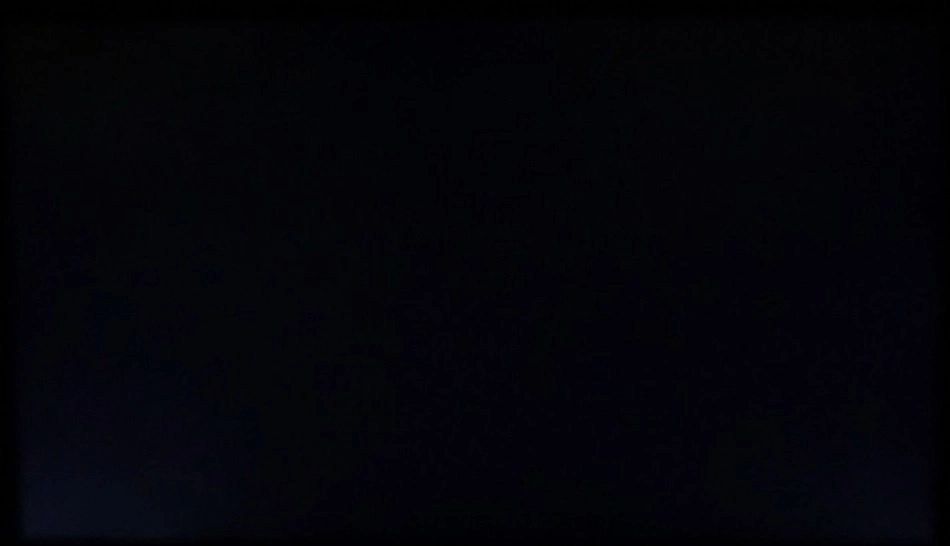
The Spyder5ELITE was used to assess the uniformity of lighter colours, represented by 9 equally spaced white quadrants running from the top left to bottom right of the screen. The table below shows the luminance recorded at each quadrant as well as the percentage deviation between each quadrant and the brightest recorded point.

Luminance uniformity table
The luminance uniformity was not great overall. The maximum luminance was recorded at ‘quadrant 8’ below the centre of the screen (158.3 cd/m²). The greatest deviation from this occurred at ‘quadrant 1’ towards the top left (139.0 cd/m², which is 19% dimmer). The average deviation between each quadrant and the brightest recorded point was 12.5%. It’s important to remember that individual units vary when it comes to uniformity and you can expect further deviation beyond the points measured. The contour map below represents these deviations graphically, with darker greys indicating lower luminance (greater deviation from brightest point) than lighter greys. The percentage deviation between each quadrant and the brightest point recorded is also given.
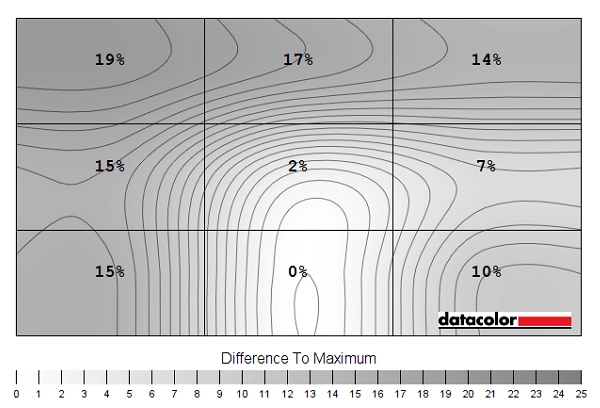
Luminance uniformity map
We also analysed colour temperature (white point) deviation of the same 9 quadrants. Deviation here is shown in DeltaE values, with higher values and darker shades on the contour map representing greater deviations from 6500K (D65) than lower values and lighter shades. A DeltaE<3 represents deviation that most users would not readily notice by eye.
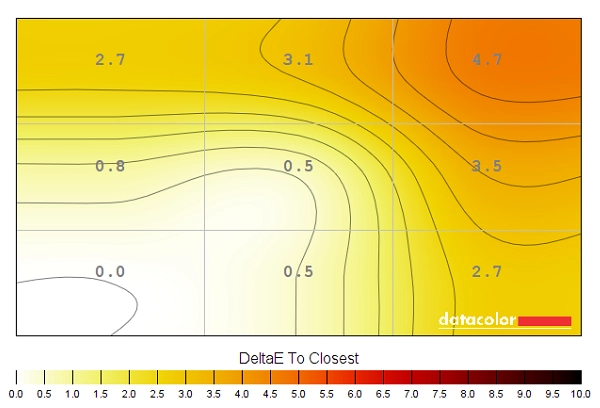
Colour temperature uniformity map
The results here were variable. We recorded significant deviations in some regions, particularly towards the top right (Delta E 4.7). When observing light shades such as white you could see that the colour temperature was somewhat warmer in this region. The left side of the screen and bottom in general was more uniform. Again, note that individual units vary when it comes to colour temperature uniformity and that you can expect further deviation beyond the measured points.
Contrast in games and movies
The monitor provided a decent contrast performance on Battlefield V, overall. Dark areas appeared with appropriate visibility for the most part, especially for the central bulk of the screen. Some dark detail was masked a little too effectively, but nothing extreme – and the ‘Standard’ mode enhances this visibility if preferred. There was some loss of detail due to ‘IPS glow’ peripherally, particularly towards the bottom two corners. This is usual for an IPS model and the level of ‘IPS glow’ on this model was quite normal for an IPS-type panel of its size. Brighter elements stood out quite nicely against darker surroundings. They appeared smoother than on some matte screen surfaces, but had a slight ‘misty’ graininess to them. This was certainly less obtrusive than the strong ‘smeary’ graininess than some matte surfaces impart.
We also observed the monitor on Shadow of the Tomb Raider, which is a good test for contrast due to the large number of scenes involving dimly lit environments. Such as caves and tombs. The monitor certainly didn’t provide the same sort of depth or atmosphere as some models, such as a VA monitor with strong contrast. And ‘IPS glow’ affected detail levels peripherally and created the usual ‘bloom’ in regions affected by it. But brighter elements still stood out quite well, and detail levels for dark content in the central region of the screen was fairly close to what it should be. You didn’t get the sort of ‘gradient of detail’ you get on TN models, either, where perceived gamma changes massively up and down the screen. And detail levels towards the top of the screen, from a normal viewing position, were not heavily masked like they would be on a TN model of this size. The screen surface gave a light graininess to brighter elements such as candles, lanterns and the daylight sky. But without a heavily layered or ‘smeary’ quality to it, thankfully.
We also made observations on the film Star Wars: The Last Jedi. This film has plenty of high-contrast scenes, with bright elements such as fires and explosions cast against a much darker background. Such scenes didn’t have the atmospheric look that models with much strong contrast would provide and again ‘IPS glow’ came into play. But the lighter elements still stood out quite well against their darker surroundings and didn’t have an overly grainy appearance from the screen surface. The detail levels in the dark scenes was largely appropriate. A little too blended, unless the ‘Standard’ setting with full factory calibration was used. But either way there was a distinct lack of a ‘blocky’ or ‘banded’ appearance from inappropriate gamma or other shade reproduction issues.
Lagom contrast tests
The Lagom tests for contrast allow specific weaknesses in contrast performance to be identified. The following observations were made.
- The contrast gradients were displayed well overall, with distinct brightness steps in most cases. The darkest two blue blocks appeared slightly more blended than ideal, but were still faintly visible.
- Performance on the black level test was quite good. It is normal for the first few blocks to appear blended on a monitor tracking the ‘2.2’ gamma curve. On this model the first four blocks were difficult to distinguish from the background, indicating a slight but not extreme masking of detail. Using the full factory calibration (‘Standard’) mode, however, revealed all blocks with distinct brightness steps. Indeed this is intentional due to how the gamma curve is tuned, as noted in the calibration section. There was no noticeable dithering and the final (white) block appeared reasonably smooth without obvious graininess from the screen surface.
- Performance in the white saturation test was strong overall. All patterns were visible against the background, although the final pattern was less distinct than it ideally would be. This is a common issue – it was masked somewhat by a light misty graininess from the screen surface.
- The greyscale gradient appeared smooth without obvious dithering or banding. The high end again appeared with a slight misty graininess rather than appearing entirely ‘pure’, but there was no ‘smeary’ or heavy graininess to be seen.
Colour reproduction
Colour gamut
The colour gamut of the U2719D (red triangle) is compared with the sRGB colour space (green triangle) in the image below under our ‘Test Settings’. The monitor offers complete sRGB coverage (100%) with a little extension beyond in the green to red and red to blue regions of this gamut representation. This gives the monitor the potential to output all shades within the sRGB colour space, with a bit of extra vibrancy and saturation in places.
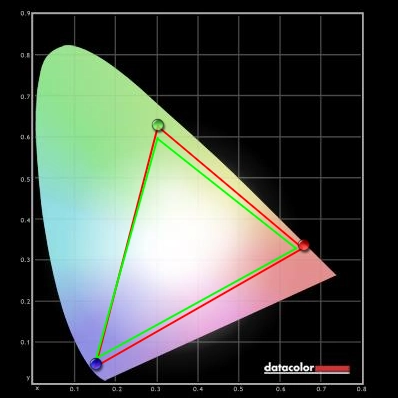
Colour gamut 'Test Settings'
For users who prefer stricter adherence to sRGB, for the sake of colour accuracy, the ‘Standard’ mode includes a full calibration which also cuts down on the colour gamut. An sRGB emulation mode, in other words. The diagram below compares the monitor in ‘Standard’ mode to the sRGB reference space. There is just a sliver of under-coverage (99%) and a tiny amount of over-coverage but really things track the sRGB space very closely. This is a good mode to use for accurate shade representation within the sRGB colour space and would be a good base for calibration as well. If you have your own calibration device and have a colour-managed workflow, the full native gamut (for 100% sRGB coverage) may be preferred although realistically either setting should work well.
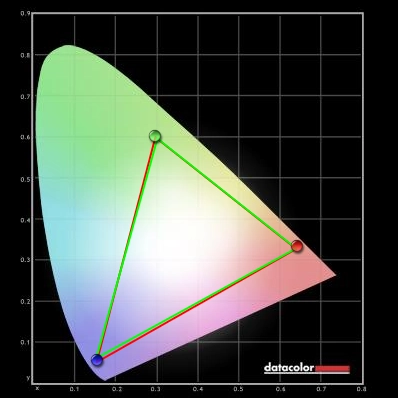
Colour gamut 'Standard'
Colour in games and movies
The monitor presented colours in a rich, varied and natural way on Battlefield V. The in-game environments showcased an excellent range of earthy browns, without the excessive red hue that can creep in on models with a more generous colour gamut. There was also a pleasing array of green shades, including some quite lush-looking deep greens and more muted pastel shades that gave vegetation a good natural look. The character skin tones showed appropriate saturation, overall, and were consistent regardless of the character’s position on the screen. There were some good vibrant elements such as rich orange fires and some brightly painted blue and green objects that stood out nicely. With a touch of extra saturation from the colour gamut, but nothing gaudy or that gave the shade a completely inappropriate saturation level.
On Shadow of the Tomb Raider the monitor again provided a pleasing palette of rich colours, with excellent subtle shade variety. The environments looked very much in-place and so did the characters in the game. Lara Croft sometimes looks to have too much of a suntan (or even sunburn) on models where the gamut strays far beyond sRGB. On this model she looked much as she should really, perhaps a touch of extra saturation but nothing particularly noteworthy. Good subtle distinctions were evident on character skin tones, clothes and vegetation in the environment as well. Helping keep the correct ‘identity’ of shades regardless of their on-screen position. There were also some nice vibrant-looking elements such as warm glowing fires, bright purple flowers and brightly painted pottery. Eye-catching but not due to strong oversaturation.
Finally, we assessed colour reproduction on the Blu-ray of Futurama: Into the Wild Green Yonder. This title again played to the strengths of the monitor, in particular colour consistency. With large areas of particular shades filling a good portion of the screen, weaknesses there tend to stand out in an obvious way. This model provided excellent consistency of any displayed shade, without the sort of clear gamma and saturation shifts of VA or in particular TN models. There was a decent eye-catching appearance to neon shades and deep shades, whilst pastel shades such as dull browns, light purples and faded reds appeared suitably muted. The strong colour consistency brought out some subtle variations of such shades which are largely lost on models with much weaker colour consistency.
Viewing angles
Lagom’s tests for viewing angle tests help explore the idea of colour consistency and viewing angle performance. The following observations were made from a normal viewing position, eyes around 70cm from the screen.
- The purple block appeared a bluish purple throughout, without obvious transitions to a pink hue.
- The red block appeared a fairly rich red throughout.
- The green block appeared a somewhat yellowish green throughout, without a stronger localised green hue in any particular region.
- The blue block appeared deep blue throughout.
- The Lagom text appeared a blended grey throughout, with a mild red tint to the striping lower down. There were no obvious shifts to more saturated red, orange or green and this remained consistent with reasonable head movement. This indicates a low viewing angle dependency to the gamma curve of the monitor, as you’d hope for from an IPS-type panel. The photo below gives a rough idea of how this text test appeared from a normal viewing position.
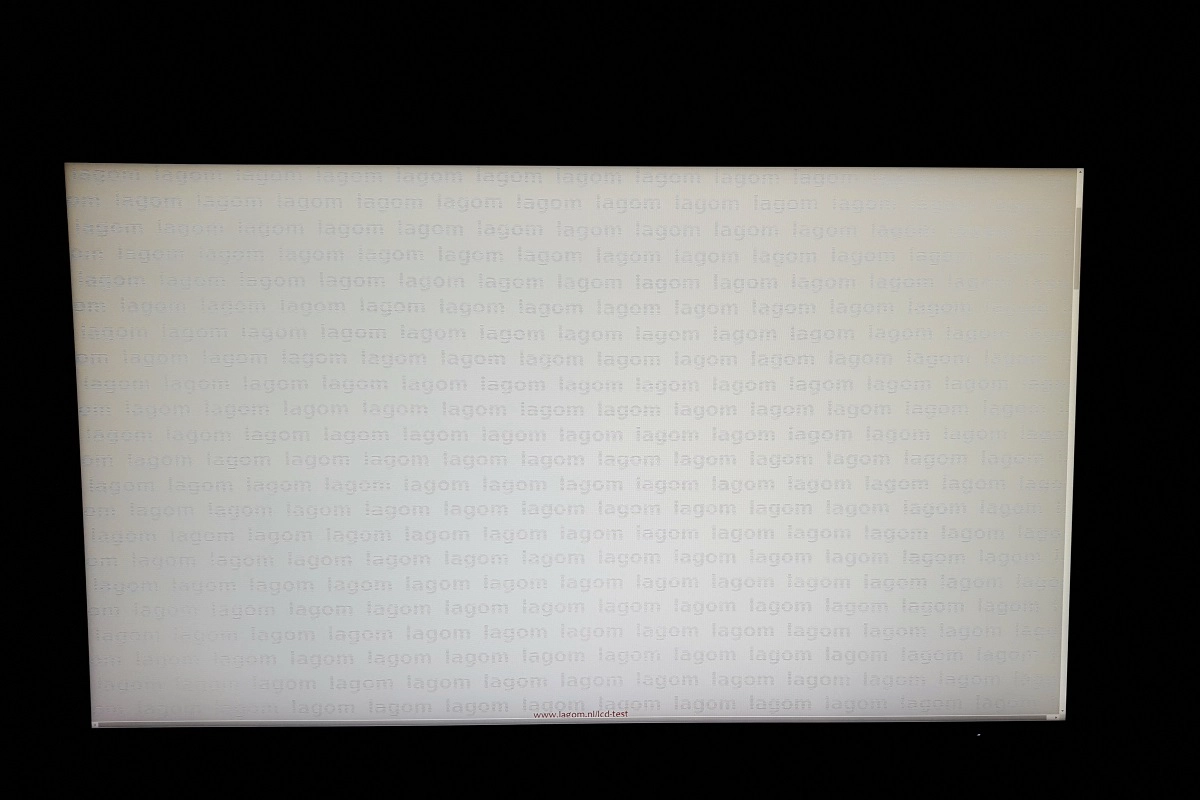
The video below shows the Lagom text, a mixed and a dark desktop background from various viewing angles. There are some slight contrast and colour shifts at sharp angles, but these are far more nuanced than you’d observe on VA or TN models. The final section of the video has a dark desktop background, highlighting ‘IPS glow’ which blooms out from more extreme angles. This is described elsewhere in the review.
Interlace pattern artifacts
On some monitors, particularly but not exclusively those with high refresh rates, interlace patterns can be seen during certain transitions. We refer to these as ‘interlace pattern artifacts’ but some users refer to them as ‘inversion artifacts’ and others as ‘scan lines’. They may appear as an interference pattern or mesh or interlaced lines which break up a given shade into a darker and lighter version of what is intended. They often catch the eye due to their dynamic nature, on models where they manifest themselves in this way. Alternatively, static interlace patterns may be seen with some shades appearing as faint horizontal bands of a slightly lighter and slightly darker version of the intended shade.
We did not observe any dynamic ‘interlace pattern artifacts’. And with the monitor running at its native 60Hz, there were no clear static interlace patterns either. There were some traces of extremely static interlacing if you looked closely, but this would be too minor for most users to notice even from close up. With the monitor overclocked to 74Hz (or much past 60Hz), though, the interlace patterns stood out more. Some shades appeared with fairly faint horizontal bands of a slightly lighter and slightly darker variant of the intended shade. The interlacing at 74Hz wouldn’t be obvious enough for some users to readily notice or be distracted by, however.
Responsiveness
Input lag
We used a small tool called SMTT 2.0 and a sensitive camera to compare the U2719D’s latency with a screen of known latency. To help maximise accuracy, over 30 repeat readings were taken. Using this method, we measured 5.82ms (under ½ a frame at 60Hz) of input lag. This value is influenced by both the element of input lag you ‘feel’ (signal delay) and the element you ‘see’ (pixel responsiveness). It indicates a fairly low signal delay which most users shouldn’t find bothersome.
Perceived blur (pursuit photography)
In our article on the topic, we explore the key factors affecting PC monitor responsiveness. Chief amongst these is the concept of perceived blur, which is contributed to not only by the monitor’s pixel responsiveness, but also the movement of our eyes as we track motion on the screen. This second factor (eye movement) is the predominant contributor to perceived blur on modern monitors, although pixel responsiveness also plays an important role. A method of photography called pursuit photography is also explored. This uses a moving rather than static camera to capture motion on a monitor in a way that simulates both eye movement and pixel responsiveness. This allows both elements of perceived blur to be highlighted, rather than simply capturing pixel responsiveness.
The following images are pursuit photographs taken using the UFO Motion Test for ghosting. The test was set to run at its default speed of 960 pixels per second, which is a good practical speed for taking such photographs and allows both key elements of pursuit blur to be demonstrated. The UFOs move across the screen from left to right at a frame rate matching the refresh rate of the display. All three rows of the test are analysed (dark, medium and light cyan background), allowing analysis of a range of pixel transitions and helping to highlight the effect of different shades (grey levels) on pixel response speeds. The monitor was tested at 60Hz (directly below) and also overclocked to 74Hz. We explore this process shortly. For the 60Hz shots we’ve included a pursuit photograph from a Dell S2417DG as a useful fast TN reference, showing how things look where pixel responsiveness isn’t a significant limiting factor.
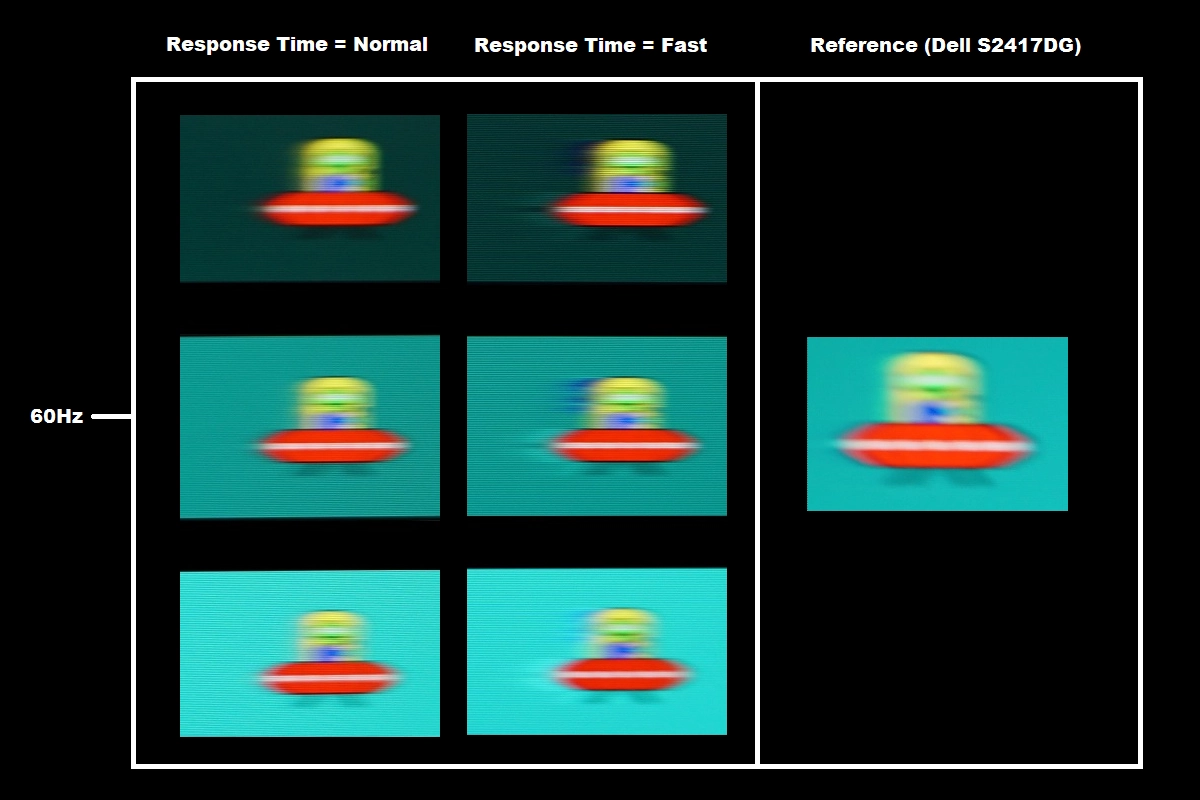
At 60Hz (above) the UFO appears soft without sharp focus or clearly defined details. This reflects a moderate amount of perceived blur attributable to eye (camera) movement. There is also some trailing behind the object. Using the ‘Normal’ response time setting, you can see a slight ‘powdery’ trailing behind the object, mostly for the dark background (top row). This indicates some weaknesses in pixel responsiveness. The ‘Fast’ setting gets rid of that but replaces it with much more eye-catching overshoot (inverse ghosting). You can see bright and colourful trailing behind the object. It’s clear from this analysis that ‘Normal’ is the preferred setting to use here. The image below shows how things look with the monitor overclocked to 74Hz.
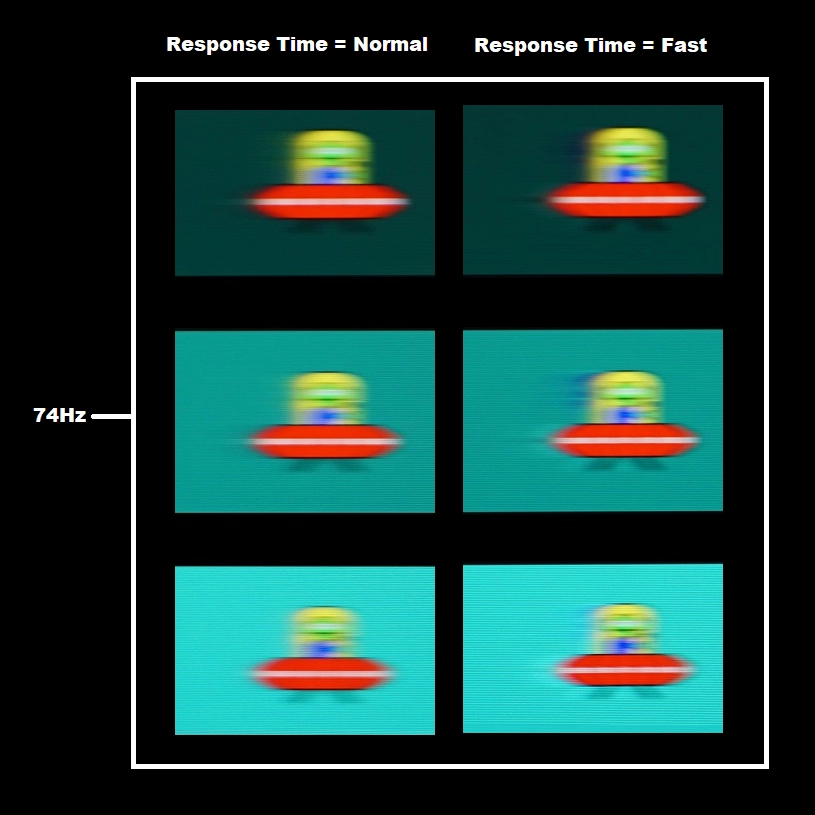
At 74Hz (above), there are no obvious differences in this test. The powdery trailing using the ‘Normal’ setting extends a little further back, although appears marginally fainter near the UFO body. The UFO itself appears quite similar. The ‘Fast’ setting again appears without obvious overshoot. There is not a distinct difference in perceived blur in this test as the UFO itself appears similar to 60Hz. That is because the extra 14Hz (and 14fps) only has a minor impact in that respect. Observing a broader spread of transitions, including some at faster speeds (i.e. when gaming) and considering how things ‘feel’ rather than just ‘look’ did reveal some slight differences as we explore shortly.
Running a custom resolution (overclocking)
We used a Custom Resolution in Nvidia Control Panel (all timings etc. left at automatic) to set the monitor to 74Hz. This was supported without significant quality degradation or other issues, so we consider this a ‘comfortable’ overclock. The exception to this was the introduction of some relatively faint interlace pattern artifacts that some users could find bothersome, as we mentioned earlier. Setting the monitor to 75Hz or above gave obvious frame skipping on our GTX 1080 Ti, so we settled for 74Hz without pushing things any higher. When it comes to overclocking, mileage may vary and there are no guarantees. The video below shows you how to create a custom resolution for the monitor with a higher refresh rate than the default of 60Hz. Note that AMD has changed the location of their ‘Custom Resolutions’ section since this video was created, but the process itself is similar. Refer to this article from AMD for information on the new interface.
In our experience we consider this sort of increase in refresh rate to be a ‘mild’ overclock that is completely within manufacturer tolerances. There is minimal risk involved and in all likelihood the monitor will last for its useful life in much the same way as if it was run at 60Hz. The general advice we give at this stage as to be aware that overclocking is something which you do at your own risk. We accept no liability should anything happen to the monitor which may or may not be due to running it at an increased refresh rate.
Responsiveness in games and movies
On Battlefield V there was a moderate degree of perceived blur, but this was predominantly caused by eye movement and linked to the 60Hz refresh rate. There were also some slight weaknesses in pixel responsiveness, which caused a bit of additional trailing on top caused by slower than optimal pixel transitions. For some transitions there was a light ‘powdery’ trailing, whilst for some transitions there was somewhat heavier ‘powdery trailing’. High-contrast transitions involving dark and significantly lighter shades would show this, for example. Even this heavy ‘powdery trailing’ was not extreme, though, and only slightly increased overall perceived blur in scenes involving a significant number of such transitions. Sometimes you could observe a bit of ‘break-up’ trailing for these sorts of transitions, too, when some of the shades contained in the object or background colour appeared to leach out slightly. This was not particularly eye-catching and these weaknesses are quite typical on 60Hz IPS-type models. There was a little bit of overshoot in places, too, generally for transitions involving brighter and medium shades. But this was not eye-catching, manifesting itself as trailing that was marginally brighter or darker than the background shades. But only slightly, so quite well-blended in its appearance.
Running the monitor at 74Hz (at 74fps) didn’t substantially affect perceived blur. It gave a slight edge overall, particularly during rapid movement. And some of the ‘powdery’ trailing became a little more extended. What was easier to notice was the edge in ‘connected feel’ this provided. This was not extreme and did not compare to the experience of running a much higher refresh rate than 60Hz. You’re only talking about 14Hz (and 14fps) increase – but it was something we quite liked. We made similar observations on Shadow of the Tomb Raider. This title had a large number of high-contrast transitions as there were plenty of dark areas illuminated by point-sources of light. There was again some ‘powdery’ trailing in places and a little ‘break-up’ trailing, but we didn’t find this distracting or particularly noticeable during normal gameplay. It was by far the more minor contributor to perceived blur compared to the limitations imposed by the refresh rate itself. There was no real overshoot to speak of, just some traces in places but nothing that really stood out. We also enjoyed the bump up to 74Hz in terms of ‘connected feel’, although the slight edge in perceived blur was nothing to write home about really.
We also observed a variety of movie content running at various frame rates, from ~24fps to 60fps. The higher frame rate content appeared much as our game testing, without any real stand-out weaknesses but rather some slight weaknesses for some transitions. Nothing that impeded our viewing pleasure. The lower frame rate content (~24fps and 30fps) appeared much as it would on even a very fast TN model, with the frame rate itself being the key barrier to fluidity. Even the slower pixel transitions on the monitor were fast enough for an optimal performance here without imparting any notable weaknesses. There was again no obvious overshoot, regardless of the frame rate of the content.
As an Amazon Associate I earn from qualifying purchases made using the below link. Where possible, you’ll be redirected to your nearest store. Further information on supporting our work.
|
Interpolation and upscaling
On some systems, the 2560 x 1440 (WQHD) resolution might be considered too graphically demanding to use for some tasks. And there are some systems, such as many games consoles, that will only output at a lower maximum resolution such as 1920 x 1080 (Full HD). You may therefore need to run the monitor at a lower resolution, such as Full HD, with the monitor using a scaling (interpolation) process to map the image onto its 2560 x 1440 pixels. To ensure optimal image quality you’ll want to ensure the monitor is handling the scaling process rather than the GPU. So you’ll need to make sure the GPU driver is correctly configured so that the GPU doesn’t take over the scaling process. For AMD GPU users that are using this monitor, the driver is set up correctly by default to allow the monitor to interpolate where possible. Nvidia users should open Nvidia Control Panel and navigate to ‘Display – Adjust desktop size and position’. Ensure that ‘No Scaling’ is selected and ‘Perform scaling on:’ is set to ‘Display’ as shown in the following image.

Note that the monitor includes an ‘Aspect Ratio’ setting in the ‘Display’ section of the OSD, as shown in the video earlier in the review. This includes a ‘1:1’ pixel mapping feature that will only use the pixels called for in the source resolution to present an undistorted, unstretched and unsoftened image with black border around. If you keep things at default and use ‘Wide 16:9’ or alternatively use ‘Auto Resize’, the monitor will use its interpolation process. Running the monitor at 1920 x 1080 (Full HD) provided a somewhat softer look to the image when compared to a native 27” Full HD display. This softening was actually relatively slight, though, with the texture detail and edge definition maintained better than most monitor interpolation processes. You can also adjust the ‘Sharpness’ setting in the OSD if you like a ‘sharper’ look, although we found the neutral setting worked best and higher settings appeared artificially over-sharpened without really improving the image in any way. The interpolation process of the monitor is therefore quite usable should you need to use the Full HD resolution for anything, including console gaming.
As usual, if you’re running the monitor at 2560 x 1440 and viewing 1920 x 1080 content (for example a video over the internet or a Blu-ray, using movie software) then it is the GPU and software that handles the upscaling. That’s got nothing to do with the monitor itself – there is a little bit of softening to the image compared to viewing such content on a native Full HD monitor, but it’s not extreme and shouldn’t bother most users.
Video review
The video below summarises some of the key points raised in this written review and shows the monitor in action. The video review is designed to complement the written piece and is not nearly as comprehensive.
Timestamps:
Features & Aesthetics
Contrast
Colour reproduction
Responsiveness
Conclusion
Dell’s UltraSharp series are an established favourite for users looking for a good mix of image quality and performance. In keeping with its predecessors, the Dell U2719D features a minimalistic design without any bold design features. Matte black and silver plastics, slim bezels and a fully ergonomically flexible stand with reasonably small-footprint base. The accuracy of the factory calibration has been something that has steadily improved with successive UltraSharp generations. This model was no exception, with an excellent factory calibration which would allow most users to be very happy and confident in the screen’s output after simply setting brightness to their taste. For users who prefer a touch of extra vibrancy at the expense of accuracy, the native gamut of the monitor can be used outside of the factory default ‘Standard’ mode. It extends a bit beyond sRGB but not to an extreme degree. Colours appeared rich, in-place and consistent with some good vibrant elements without obvious oversaturation.
The contrast performance was much as we expected given the panel type. A moderate amount of ‘IPS glow’ ate away at some detail peripherally, particularly towards the bottom corners. Static contrast sat close to 1000:1, with a bit of variation depending on settings used. There were no noticeable gamma inconsistencies across or up and down the screen, distancing this model from VA and moreover TN panels where detail levels vary considerably depending on the section of the screen you’re observing. So a reasonable contrast performance, overall. The screen surface departed from other some other recent 25-27” WQHD UltraSharps as it employs a medium (‘relatively light’) matte anti-glare finish. This is not quite as smooth or light and gives a slight ‘misty’ graininess to the image. This was by no means extreme and there was not a smeary or ‘layered’ appearance to the graininess. Overall clarity and vibrancy was maintained well, alongside relatively good glare handling.
As far as 60Hz monitors go the monitor proved quite responsive. There were minor weaknesses in terms of pixel responsiveness in places, giving some ‘powdery trailing’. But this was not really eye-catching and didn’t add hugely to overall perceived blur. There was no noteworthy overshoot and the monitor, overall, made good use of its 60Hz refresh rate. Input lag was also fairly low and, for those who like a bit of an edge in ‘connected feel’ and perceived blur, we were able to overclock the monitor to 74Hz. This introduced some static ‘interlace pattern artifacts’ which some users could find bothersome, although they were reasonably faint and not everyone would find them annoying or necessarily even notice them.
Overall the Dell U2719D is a welcome addition to the UltraSharp series. Some nit-picks would include that we would’ve preferred to see a lighter and smoother matte screen surface employed, there were some uniformity issues on our sample and a 60Hz refresh rate with mild overclockability is somewhat restrictive for fast-paced gaming. But if you’re happy with the refresh rate, then this is a definite contender. It offers strong ‘out of the box’ performance, a range of useful OSD settings and a nice (and sensible) design. So a lot of important boxes ticked. Coupled with a reasonable price tag, we feel this is a model that deserves some careful consideration and perhaps deserves a spot on your desk.
The bottom line; strong ‘out of the box’ performance, decent responsiveness and excellent colour reproduction within the sRGB colour space.

| Positives | Negatives |
| A strong factory calibration with pleasing balance (including good gamma and white point on our unit), good sRGB colour space coverage and pleasing consistency from the IPS-type panel | No support for extended colour spaces, although a bit of extension beyond sRGB outside of the ‘Standard’ setting for users who like that kind of thing |
| Decent static contrast and good glare-handling from the screen surface | Slight graininess when observing lighter shades due to the use of a medium matte screen surface, a departure from its predecessor(s) |
| Fairly low input lag and well-tuned pixel responsiveness, giving a good overall 60Hz performance – plus the ability to apply a mild overclock | Some minor weaknesses in pixel responsiveness in places, some users would prefer a significantly higher refresh rate |
| Good ergonomic flexibility, a good usable resolution and pixel density plus a sensible design with a fairly sleek, modern and minimalistic appearance | OSD is quite feature-rich, although lacks different gamma modes |
As an Amazon Associate I earn from qualifying purchases made using the below link. Where possible, you’ll be redirected to your nearest store. Further information on supporting our work.
|

